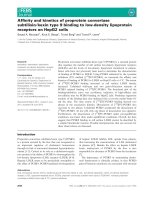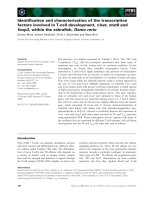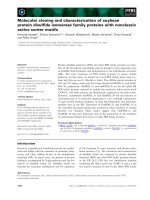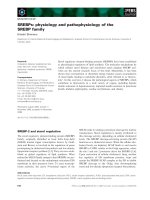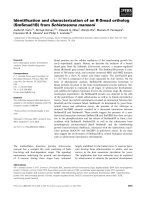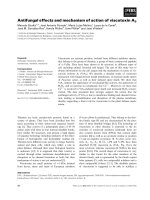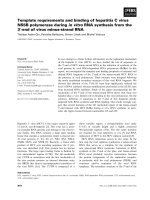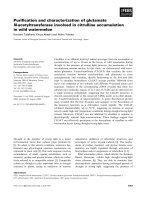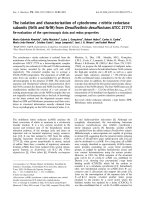Báo cáo khoa học: " Enhanced detection and study of murine norovirus-1 using a more efficient microglial cell line" pps
Bạn đang xem bản rút gọn của tài liệu. Xem và tải ngay bản đầy đủ của tài liệu tại đây (447.74 KB, 7 trang )
BioMed Central
Open Access
Page 1 of 7
(page number not for citation purposes)
Virology Journal
Research
Enhanced detection and study of murine norovirus-1 using a more
efficient microglial cell line
Courtney Cox
1
, Shengbo Cao
2
and Yuanan Lu*
2
Address:
1
Department of Microbiology, College of Natural Sciences, University of Hawaii at Manoa, Honolulu, HI 96822, USA and
2
Department
of Public Health Sciences, John A. Burns School of Medicine, University of Hawaii at Manoa, Honolulu, HI 96822, USA
Email: Courtney Cox - ; Shengbo Cao - ; Yuanan Lu* -
* Corresponding author
Abstract
Background: Human Noroviruses are the predominant cause of non-bacterial gastroenteritis
worldwide. To facilitate prevention and control, a norovirus isolated from mice can provide a
model to understand human noroviruses. To establish optimal viral infectivity conditions for
murine noroviruses, several cell lines of hematopoietic lineage, including murine BV-2, RAW 264.7,
and TIB, as well as human CHME-5, were tested comparatively for their sensitivity to murine
norovirus-1.
Results: Except for CHME-5, all three murine-derived cell lines were susceptible to MNV
infection. Viral infection of these cells was confirmed by RT-PCR. Using both viral plaque and
replication assays, BV-2 and RAW 264.7 cells were determined to have comparable sensitivities to
MNV-1 infection. Comparisons of cell growth characteristics, general laboratory handling and
potential in-field applications suggest the use of BV-2 to be more advantageous.
Conclusion: Results obtained from these studies demonstrate that an immortalized microglial cell
line can support MNV-1 replication and provides a more efficient method to detect and study
murine noroviruses, facilitating future investigations using MNV-1 as a model to study, detect, and
control Human Norovirus.
Background
Noroviruses belong to the family Caliciviridae and are a
group of small, icosahedral, non-enveloped, positive-
strand RNA viruses [1-6]. Most norovirus genomes range
from 7.7-7.9 KB and contain three highly conserved open
reading frames (ORF)[3]. Human Norovirus (HNV)
strains are the predominant cause of non-bacterial gastro-
enteritis worldwide and are primarily transmitted through
the fecal-oral route, usually by the consumption of con-
taminated food or water [1-3,7-12].
Despite worldwide occurrence and high level of inci-
dence, there are no drug treatments or vaccines available
to date. In fact, little is known about human norovirus
biology due to the lack of a cell culture system or small-
animal model for use in studies [7,9,13-16]. To facilitate
the prevention and control of this human pathogen, a
norovirus isolated from murine animals is currently con-
sidered as a model to understand human norovirus repli-
cation, life cycle, pathogenesis, and host immune
response [7,14]. Recent studies have demonstrated that
Published: 10 November 2009
Virology Journal 2009, 6:196 doi:10.1186/1743-422X-6-196
Received: 18 September 2009
Accepted: 10 November 2009
This article is available from: />© 2009 Cox et al; licensee BioMed Central Ltd.
This is an Open Access article distributed under the terms of the Creative Commons Attribution License ( />),
which permits unrestricted use, distribution, and reproduction in any medium, provided the original work is properly cited.
Virology Journal 2009, 6:196 />Page 2 of 7
(page number not for citation purposes)
MNV-1 and human norovirus share many biochemical
and genetic characteristics, including their genome,
genomic organization and function, virion size (28 to 35
nm in diameter), shape, and buoyant density [16],
induced symptoms [16], and transmission in nature, pri-
marily via the fecal-oral route [16]. In particular, murine
norovirus is known to be the only isolate among the five
noroviral genogroups to replicate in cell culture and in
small animals (mice), making it an excellent candidate as
an experimental model for human norovirus [7,14,16].
The MNV-1 model has already provided some insights
into norovirus biology. It was discovered that noroviruses
possess a tropism for macrophages and dendritic cells
during replication [7,16]. Wobus et al. (2004) showed
that MNV-1 replicates readily in cell lines with a hemat-
opoietic lineage, including the RAW 264.7 cell line, as
well as in primary bone-marrow derived macrophages
and dendritic cells. While it has been shown that other
macrophage and dendritic cell lines, including IC21,
P388D1, WBC264-9C and JAWSII, can also support
MNV-1 replication [16], RAW 264.7 cells currently repre-
sent the most widely utilized immortalized cell line for
MNV studies.
To facilitate the development of MNV-1 as a model for
human norovirus, it is important to establish optimized
in vitro laboratory conditions for MNV-1 infection and
detection, including testing and identifying other hemat-
opoietic cell lines for their susceptibility to MNV-1. This
study describes a comparative test and evaluation of four
readily available cell lines of hematopoietic lineage,
including murine-derived microglial BV-2, murine-
derived macrophages RAW 264.7 and TIB, as well as
human-derived microglial CHME-5, for their potential
use in detecting and studying MNV-1, and identifies a
murine microglial cell line (BV-2) as a novel cell culture
system for studying MNV-1, thus extending the current
use of MNV-1 as a model for human norovirus.
Methods
Virus
Murine norovirus (MNV-1, generously provided by Dr.
Philip C. Loh, The University of Hawaii Manoa) was ini-
tially propagated in RAW 264.7 cells. Cells were seeded
into a TC-75 cm
2
flask so that an approximately 80-90%
cell monolayer formed within 24 hours. Immediately
prior to infection, all medium was removed and 250 μL of
previously made viral stock in 2 mL of serum-free
medium was added into the flask. The flask was incubated
for 1 hour at 37°C with 5.0% CO
2
, and then washed twice
with serum-free medium. Following the two washes, 10
mL of medium supplemented with 5% fetal bovine serum
(FBS) (HyClone, Logan, UT) was added into the flask. The
flask was then incubated for 48 hours, until approxi-
mately 90% viral-induced cytopathic effects (CPE)
(rounding of cells, loss of contact inhibition and cell
death) were observed. The flask was then stored at -80°C.
After a 24-hour storage, the flask was then allowed to thaw
at room temperature (RT). Following an additional freeze-
thaw cycle, the content of the flask was completely
removed and centrifuged at 3000 rpm for 5 minutes to
remove all cellular debris. Supernatant was then removed
and aliquoted into 1.5 mL microfuge tubes at 0.5 mL/
tube. The viral aliquots were stored long-term at -80°C.
Cell cultures
Four cell lines with a hematopoietic lineage, including
murine BV-2 (Provided by Dr. Paul Jolicoeur, Université
de Montréal), RAW 264.7 (ATCC Manassas, VA) and TIB
(ATCC Manassas, VA), as well as human CHME-5 (Pro-
vided by Dr. Pierre Talbot, Université du Québec), were
used throughout these experiments. All cell cultures were
grown in high-glucose Dulbecco's modified eagle's
medium (DMEM) (Sigma-Aldrich St. Louis, MO), supple-
mented with 10% FBS, penicillin (100 IU/mL) and strep-
tomycin (100 μg/mL) (Sigma-Aldrich St. Louis, MO).
Defined FBS (HyClone, Logan, UT) was used for the RAW
264.7 and TIB cell lines, while standard FBS (HyClone)
was used for the BV-2 and CHME-5 cell lines. Cells were
grown and maintained according to standard animal cell
culture protocols and kept at 37°C with 5% CO
2
.
Viral infection
Twenty-four hours prior to infection, cells in the exponen-
tial growth phase were harvested and seeded into 75 cm
2
tissue culture (TC-75) flasks at a density that allowed for a
single cell monolayer within 24 hours. Immediately
before infection, medium was removed and cells were
washed twice with DMEM containing no FBS (DMEM-0).
MNV-1 in serum-free high-glucose DMEM was added to
each flask giving a multiplicity of infection (MOI) of 2.
Cells were incubated for one hour at 37°C with 5% CO
2
.
Flasks were rocked gently every 15 minutes for equal viral
distribution. At the end of the one-hour adsorption, the
inoculum was removed and replaced with 10 mL of the
high-glucose DMEM containing 5% FBS (DMEM-5). The
cells were then incubated for three days at 37°C with 5%
CO
2
. Photomicrographs were taken on a daily basis to
document specific viral-induced cytopathic effects (CPE).
RNA Isolation and RT-PCR
Forty-eight hours after infection, cells were collected,
washed twice with Dulbecco's phosphate buffered saline
(DPBS) (Sigma-Aldrich St. Louis, MO), and pelleted by
centrifugation. RNA isolation was performed with the
RNeasy Mini Kit (Qiagen, Valencia, CA), according to the
manufacturer's instructions. Isolated total RNA was pre-
pared in a final concentration 5 μg/ml.
Virology Journal 2009, 6:196 />Page 3 of 7
(page number not for citation purposes)
In order to confirm susceptibility of test cell cultures to
MNV-1 infection, reverse-transcriptase polymerase chain
reaction (RT-PCR) was performed using newly-designed
oligonucleotide primers specific to the MNV-1 genome
(Forward 5'-ATCGTGCTGAGCTGTGATTG {M1} and
Reverse 5'-GTCAAGAGCAAGGTCGAAGG {M2}, NC-
008311 Genbank). cDNA was initially generated using
SuperScript II Reverse Transcriptase (Invitrogen, Carlsbad,
CA) and random hexamers (Invitrogen, Carlsbad, CA),
according to the manufacturer's instructions. PCR was
then performed using the primer pair with an initial dena-
turing at 94°C for 5 min., followed by 35 cycles of dena-
turing at 94°C for 1 min., annealing at 60°C for 1 min.,
and extension at 72°C for 1 min., and then a final exten-
sion at 72°C for five minutes. Upon completion of the
PCR reaction, samples were held at 4°C and then sub-
jected to 2% agarose gel electrophoresis, along side a 100
bp marker (Perfect DNA™ 100 bp Ladder, Novagen, Gibb-
stown, NJ). Cell lines determined to be susceptible to
MNV-1 were used for further testing.
Plaque assay
The sensitivity of three murine microglial cells to MNV-1
was quantitatively compared using a newly established
viral plaque assay protocol developed in this laboratory.
In brief, cells were seeded into 6-well plates at a rate of
~7.5 × 10
4
cells/well for the BV-2 cell line and ~5.5 × 10
5
cells/well for the RAW 264.7 cell line, densities that
allowed the formation of a confluent monolayer within
24 hours. Immediately before MNV-1 infection, a series of
10-fold dilutions of a MNV-1 stock prepared in DMEM-0
were similarly inoculated onto the three murine cell lines
grown in the 6-well plates, following aspiration of the
medium and two cell washes with DMEM-0. Plates were
then incubated for one hour at 37°C in a humidified 5%
CO
2
incubator, with gentle rocking every 15 minutes to
allow even distribution of the viral inoculum. All liquid
was removed from the plates and cells were covered with
2 mL/well of a 1.5% methylcellulose overlay medium.
After three days, cells were fixed and stained with 2 mL/
well of crystal violet-formalin solution for eight hours.
Plates were vigorously washed with tap water and viral
induced plaques were counted. Titers were calculated and
compared between the different cell cultures.
Replication Assay
In addition, MNV-1 replication in the BV-2 and RAW
264.7 cell lines was also comparatively analyzed using a
single-step viral replication assay. Briefly, BV-2 and RAW
264.7 cells at their exponential phase were harvested as
previously described, and seeded into 24 separate T-25
cm
2
tissue culture flasks (Cellstar Greiner Bio-One, Mon-
roe, NC), 12 per group, at a rate of 1.8 × 10
5
cells/flask in
5 mL DMEM cell growth medium. Cells were then incu-
bated at 37°C with 5% CO
2
to allow cell monolayer for-
mation. After a 24-hour incubation, medium was
removed from the flasks and cells were washed twice with
serum-free medium DMEM-0. Diluted MNV-1 in serum-
free high-glucose DMEM was added to each of the flasks,
giving a final MOI of 2.0. Cells were then incubated at
37°C with 5% CO
2
for 48 hours. Every four hours, one
flask per infected cell group was removed from the incu-
bator. The medium from each flask (representing the
extracellular virus) was collected and stored separately in
a 15 mL centrifuge tube at -80°C. Cells attached to each
flask (representing the intracellular virus) were washed
twice with sterile DPBS, and also stored at -80°C. This
process was repeated until a total of 12 samples over a 48-
hour time period were taken for each infected cell line.
Viral titers of both extracellular and intracellular virus at
each time point were determined by plaque assay (as pre-
viously described) and totaled.
Results
Susceptibility of cells to infection by MNV-1
Four cells lines of hematopoietic lineage were tested com-
paratively for their sensitivity to MNV-1 infection. Their
viral susceptibility was evaluated by both the appearance
of viral-induced CPE (rounding of cells, loss of contact
inhibition, and cell death) and the production of infec-
tious viral particles. The results show that all three
murine-derived cell lines are susceptible to MNV-1 infec-
tion. Viral-induced CPE was observed in the BV-2 cell line
as early as 16 hours post-infection, with 100% CPE occur-
ring after three days (Figure 1). Infection of the RAW and
TIB cells showed signs of visible CPE at 18 hours post-
infection, and also had 100% CPE occurring 3 days post-
infection (Figure 1). However, the human-derived CHME-
5 cell line appeared refractory to MNV-1 infection, as no
viral-induced CPE was observed at any time period (data
not shown).
In order to confirm susceptibility to MNV-1 infection, RT-
PCR was performed on RNA isolated from all four MNV-
1 infected cell lines, using primers designed to amplify a
conserved portion of the MNV-1 genome. Results con-
firmed that all three murine-derived cell lines are suscep-
tible to MNV-1 infection (as evident from the appearance
of the expected RT-PCR products) and that the human-
derived CHME-5 microglial cell line is refractory to MNV
infection (Figure 2). Representative amplicons were
sequenced and shown to have a 100% sequence identity
to the respective genomic portion of MNV-1 (data not
shown). To ensure accurate results, the experiment was
performed in triplicate.
Sensitivity of cells to infection by MNV-1
In order to compare the sensitivities of the susceptible cell
lines to MNV-1, both viral plaque and replication assays
were performed. Plaque assay data (Figure 3a) shows that
Virology Journal 2009, 6:196 />Page 4 of 7
(page number not for citation purposes)
when infected with the same viral stock, BV-2 appears to
be the most sensitive cell line to MNV-1 detection, with a
titer of 3.6 × 10
8
pfu/mL (Figure 3b), followed by RAW
264.7 cell line, with a comparable viral titer of 1.5 × 10
8
pfu/mL (Figure 3c). The TIB cell line appeared to be the
least sensitive cell line to MNV-1 infection, producing a
titer of 2.2 × 10
7
pfu/mL (Figure 4), one order of magni-
tude lower than the other two cell lines.
To further confirm these findings, a single-step replication
assay for MNV-1 grown in both the BV-2 and RAW 264.7
cell lines was performed. These two cell cultures were
infected with a same MNV-1 stock and incubated for 48
hours, with samples of both intracellular and extracellular
virus being taken every 4 hours. MNV-1 titers were calcu-
lated for each time point using plaque assays, and a
growth curve of total MNV-1 replication in each cell line
was plotted. As seen in Figure 5, both curves show a short
eclipse period of viral replication, with MNV-1 replication
becoming detectable at 4 hours post-infection. In both
cell lines, replication continued exponentially until 40
hours post-infection, at which time it reached a constant
viral titer of over 10
9
pfu/mL (Figure 5). Comparison
between the two viral replication curves shows that MNV-
1 begins to replicate within the same time period in both
cell lines and reaches similar end-point titer values. In
sum, these data confirm that the BV-2 and RAW 264.7 cell
lines are generally equal in their susceptibility to MNV-1
infection, and their ability to produce virus particles.
Discussion
Currently, there is no cell culture or small animal model
available for studying human norovirus strains, thus pre-
senting a need to find an appropriate model [7,9,13-16].
MNV-1 is an excellent candidate model to study norovirus
biology because of its similarities to human noroviruses
Susceptibility of cells to MNV-1 infectionFigure 1
Susceptibility of cells to MNV-1 infection. Four cell lines BV-2 (1a), RAW 264.7 (1b) and TIB (1c) were infected with
MNV-1. Photomicrographs were taken to visualize CPE at selected post-infection times: cells pre-infection (A) and extensive
CPE at 72 hours post-infection (B). Original magnification was at 100×.
RT-PCRFigure 2
RT-PCR. Confirmatory detection of MNV-1-infection of
test cells. Total cellular RNA isolated from MNV-1 infected
cells was subjected to the RT-PCR amplification as described
in method section. Results show that the BV-2, RAW 264.7
and TIB cell lines were infected by MNV-1 (as evident by the
appearance RT-PCR product), while CHME-5 appears to be
refractory to MNV-1 infection. Lanes: 1 = 100 bp marker, 2
= MNV-infected BV-2 cells, 3 = MNV-infected RAW 264.7
cells, 4 = MNV-infected TIB cells, 5 = infected CHME-5 cells,
and 6 = Negative control (ddH
2
O).
Virology Journal 2009, 6:196 />Page 5 of 7
(page number not for citation purposes)
[16], as well as the fact that it replicates in both cell culture
and small animals [7]. Establishment and optimization of
this model are important, as it provides an opportunity to
study norovirus biology in a natural host. Previous studies
of MNV-1 have shown that murine norovirus has a tro-
pism for macrophage and dendritic cells, leading to the
development of the first cell culture and plaque assay sys-
tems for norovirus [7,14]. In order to further establish the
use of MNV-1 as a model, these experiments were per-
formed to test and compare four readily available cell
lines for their susceptibility and sensitivity to MNV-1
infection.
Initially, four cell lines were tested for their susceptibility
to MNV-1 infection by direct infection of these cells with
MNV-1 stock. The results showed that all three murine-
Comparative plaque assays for MNV-1 detectionFigure 3
Comparative plaque assays for MNV-1 detection.
Cells were infected with same preparation of diluted MNV-1,
maintaining a consistent MOI. Following a one-hour adsorp-
tion period, infected cultures were covered with a 1.5%
methylcellulose overlay medium. Cells were then stained
with a crystal violet-formalin solution at day 3 post infection
and titers were calculated. A. BV-2 plaque assay; B. RAW
264.7 plaque assay; and C. TIB plaque assay.
Comparative graph of plaque assay resultsFigure 4
Comparative graph of plaque assay results. BV-2 pro-
duced a titer of 3.1 × 10
8
pfu/mL. The RAW 264.7 cell line
produced a comparable viral titer of 1.93 × 10
8
pfu/mL. The
TIB cell line produced a titer of 2.17 × 10
7
pfu/mL;
Replication AssayFigure 5
Replication Assay. Cells were infected with a MOI of 2 and
allowed to incubate for 48 hours at 37°C with 5% CO
2
. Sam-
ples were taken every four hours and viral titers were deter-
mined by plaque assay. The replication curve of MNV-1 in
both the BV-2 and RAW 264.7 cell lines was then plotted.
Results are showing similar growth and viral titer production
in both cell lines, among all time points.
Virology Journal 2009, 6:196 />Page 6 of 7
(page number not for citation purposes)
derived cell lines were susceptible to MNV-1 infection, as
evident by the appearance of viral induced CPE in the
infected cell cultures, which became more extensive with
time. MNV-1-infection of these cell cultures was then con-
firmed by the positive detection of the target MNV-1 gene
from the infected cells using RT-PCR and subsequent
sequence analysis of the representative amplicons, which
showed a 100% sequence identity to the MNV-1 genome.
The sensitivities of the three susceptible cell lines to MNV-
1 were then compared using a newly modified viral
plaque assay protocol established for optimal quantita-
tion of infectious MNV-1. Plaque assays using an agarose
or agar overlay medium have been used reported for
MNV-1 infection studies, followed by staining with a neu-
tral red dye [7]. However, these methods can be ineffi-
cient, especially when plaque assays are performed in
large quantities, as both agarose and agar harden quickly,
thus creating the need for multiple heat/thaw methods.
Therefore, a plaque assay system with a methylcellulose-
based overlay medium was tested and developed. A
0.75% methylcellulose overlay medium, which is com-
monly used for marine viral titration, was initially used.
However, the MNV-1-induced plaques formed under
these conditions appeared very smeared and indistinct,
suggesting an ineffective localization of MNV-1 replica-
tion at 37°C. This observation led to the serial increase of
methylcellulose concentration to 1.5%, which was found
to be sufficient to contain viral infection to foci, allowing
for distinct plaque formation.
The comparative plaque assay results showed that BV-2
cells were at least equally sensitive to MNV-1 detection as
compared to RAW 264.7 cells, the currently used model
for the virus. To further compare the sensitivity of BV-2
with RAW 264.7 cells, a single-step MNV-1 replication
assay was performed in both the BV-2 and Raw 264.7
cells. The results obtained from this test showed that the
MNV-1 replication curve in RAW 264.7 cells is consistent
with those observed in previous replication studies [17].
This data also showed that the replication curves between
the RAW 264.7 and BV-2 cell lines looked very similar in
nature, with endpoint viral titers appearing equivocal
between these two cell lines. These findings further con-
firm previous results that, like RAW 264.7 cells, the BV-2
cell line is very sensitive to MNV-1 infection and repre-
sents a new in vitro system for studying MNV-1.
As compared to RAW 264.7 cells, the BV-2 cell line has
shown to be a more efficient cell culture system to be used
for MNV-1 studies. BV-2 cells are known to grow quickly
and can be resilient. This allows for quick cell propagation
and eliminates the need for more challenging cell passage
methods such as cell scraping, as needed for RAW 264.7
cells. Instead, basic cell culturing methods like trypsiniza-
tion can be used regularly. In addition, the BV-2 cell line
is very easy to maintain and has fewer nutritional require-
ments and does not secrete cellular toxins that interfere
with cellular growth and medium pH levels (unpublished
observation), whereas constant care is required for the
RAW 264.7 cells. Lastly, the larger cell size of BV-2 makes
it more useful than RAW 264.7 cells as a simple detection
system. The presence of virus in unknown samples, such
as environmental samples, could be more easily detected
in the BV-2 cell line than in an identical assay using the
RAW 264.7 cell line. The larger cell size allows for the use
of less BV-2 cells than RAW 264.7 cells in identical assays,
yielding a higher MOI. As MOI is important for viral infec-
tivity, having a higher MOI in BV-2 than in RAW 264.7
cells is highly beneficial. This strongly suggests that sam-
ples containing smaller amounts of virus could still be
tested in the BV-2 assay, while possibly falling below
detectable levels in an identical assay utilizing RAW 264.7
cells. Overall, these findings support the use of BV-2 as a
more efficient cell culture system to study MNV-1.
Conclusion
These data show that two new murine-derived microglial/
macrophage cell lines are sensitive to MNV-1 infection
and support the use of the BV-2 cell line in future studies
of MNV-1. While future research should also involve test-
ing other murine microglial and macrophage cell lines for
increased sensitivities to MNV-1, present research has
established new laboratory techniques that allow the use
of an alternative cell line to study MNV-1. Inaddition, test-
ing this cell line for its susceptibility to other MNV strains
will be beneficial in determining the utility of this cell line
as a model to study norovirus. This cell line, as well as
undiscovered cell lines, will lay the essential groundwork
for future investigations to establish the use MNV-1 as a
model to study, detect, and control human noroviruses.
Competing interests
The authors declare that they have no competing interests.
Authors' contributions
CC carried out all experimental testing and drafted the
manuscript. SC participated in the design of the study by
providing technical assistance to CC regarding plaque
assays. YL conceived of the study, and participated in its
design, coordination, and data analysis and manuscript
revision. All authors read and approved the final manu-
script.
Acknowledgements
We would like to thank Yongbo Yang for his technical assistance in this
study and Jarred Yasuhara-Bell for his comments on manuscript prepara-
tion. This research was supported in part by grants from the Centers for
Oceans and Human Health (COHH) program, of the National Institutes of
Environmental Health Sciences (P50ES012740), National Institutes of
Health, and the National Science Foundation (OCE04-32479), and a grant
Publish with Bio Med Central and every
scientist can read your work free of charge
"BioMed Central will be the most significant development for
disseminating the results of biomedical research in our lifetime."
Sir Paul Nurse, Cancer Research UK
Your research papers will be:
available free of charge to the entire biomedical community
peer reviewed and published immediately upon acceptance
cited in PubMed and archived on PubMed Central
yours — you keep the copyright
Submit your manuscript here:
/>BioMedcentral
Virology Journal 2009, 6:196 />Page 7 of 7
(page number not for citation purposes)
from the National Science Foundation (OCE09-11000; and University of
Hawaii National Science Foundation Integrated Graduate Research and
Training Program (IGERT, 0549514).
References
1. Atmar RL, Estes MK: Diagnosis of noncultivable gastroenteritis
viruses, the human caliciviruses. Clin Microbiol Rev 2001,
14:15-37.
2. Atmar RL, Estes MK: The epidemiologic and clinical impor-
tance of norovirus infection. Gastroenterol Clin North Am 2006,
35:275-290.
3. Center for Disease Control: CDC technical fact sheet about
Noroviruses. 2006.
4. Jiang X, Graham DY, Wang KN, Estes MK: Norwalk virus genome
cloning and characterization. Science 1990, 250:1580-1583.
5. Jiang X, Wang M, Wang K, Estes MK: Sequence and genomic
organization of Norwalk virus. Virology 1993, 195:51-61.
6. Tan M, Hegde RS, Jiang X: The P domain of Norovirus capsid
protein forms dimmer and binds to histo-blood group anti-
gen receptors. J Virol 2004, 78(12):6233-6242.
7. Wobus CE, Karst SM, Thackray LB, Chang KO, Sosnovtsev SV, Belliot
G, Krug A, Mackenzie JM, Green KY, Virgin HW: Replication of a
Norovirus in cell culture reveals a tropism for dendritic cells
and macrophages. PLoS Biol 2004, 2(12):e432.
8. Fankhauser RL, Noel JS, Monroe SS, Ando T, Glass RI: Molecular
epidemiology of "Norwalk-like viruses" in outbreaks of gas-
troenteritis in the United States. J Infect Dis 1998,
17:1571-1578.
9. Green KY, Chanock RM, Kapikian AZ: Human Caliciviruses. In
Fields Virology Volume 1. Edited by: Knipe DM, Howley PM. Pennsylva-
nia: Lippincott Williams and Wilkens; 2001:841-847.
10. Hutson AM, Atmar RL, Graham DY, Estes MK: Norovirus disease:
changing epidemiology and host susceptibility factors. Trends
Microbiol 2004, 12:279-287.
11. Lopman BA, Brown DW, Koopmans M: Human caliciviruses in
Europe. J Clin Virol 2002, 24:137-160.
12. Mead PS, Slutsker L, Dietz V, McCaig LF, Bresee JS, Shapiro C, Griffin
PM, Tauxe RV: Food-related illness and death in the United
States.
Emerg Infect Dis 1999, 5:607-625.
13. Duizer E, Schwab KJ, Neill FH, Atmar RL, Koopmans MP, Estes MK:
Laboratory efforts to cultivate norovirus. J Gen Virol 2004,
85:79-87.
14. Karst SM, Wobus CE, Lay M, Davidson J, Virgin HW: STAT-1
dependent innate immunity to a Norwalk-like virus. Science
2003, 299:1575-1578.
15. Richards GP, Watson MA, Fankhauser RL, Monroe SS: Genogroup
I and II Noroviruses detected in stool samples by real-time
reverse transcription-PCR using highly degenerate universal
primers. Appl Environ Microbiol 2004, 70(12):7179-7184.
16. Wobus CE, Thackray LB, Virgin HW: Murine Norovirus: a model
system to study Norovirus biology and pathogenesis. J Virol
Methods 2006, 80(11):5104-5112.
17. Virgin H: Murine Calicivirus. US Patent 20060172287 2006.
